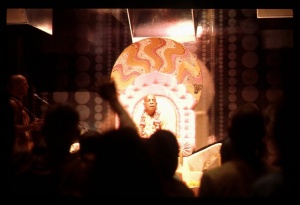CC Madhya 2.11: Difference between revisions
m (1 revision(s)) |
(Vanibot #0054 edit - transform synonyms into clickable links, which search similar occurrences) |
||
| (One intermediate revision by one other user not shown) | |||
| Line 1: | Line 1: | ||
{{ | [[Category:Sri Caitanya-caritamrta - Madhya-lila Chapter 02|C011]] | ||
<div style="float:left">'''[[Sri Caitanya-caritamrta|Śrī Caitanya-caritāmṛta]] - [[CC Madhya|Madhya-līlā]] - [[CC Madhya 2|Chapter 2: The Ecstatic Manifestations of Lord Śrī Caitanya Mahāprabhu]]'''</div> | |||
<div style="float:right">[[File:Go-previous.png|link=CC Madhya 2.10|Madhya-līlā 2.10]] '''[[CC Madhya 2.10|Madhya-līlā 2.10]] - [[CC Madhya 2.12|Madhya-līlā 2.12]]''' [[File:Go-next.png|link=CC Madhya 2.12|Madhya-līlā 2.12]]</div> | |||
{{CompareVersions|CC|Madhya 2.11|CC 1975|CC 1996}} | |||
{{RandomImage}} | |||
==== TEXT 11 ==== | ==== TEXT 11 ==== | ||
<div | <div class="verse"> | ||
kāhāṅ nāhi śuni yei bhāvera vikāra | :kāhāṅ nāhi śuni yei bhāvera vikāra | ||
sei bhāva haya prabhura śarīre pracāra | :sei bhāva haya prabhura śarīre pracāra | ||
</div> | </div> | ||
| Line 12: | Line 16: | ||
==== SYNONYMS ==== | ==== SYNONYMS ==== | ||
<div | <div class="synonyms"> | ||
''[//vanipedia.org/wiki/Special:VaniSearch?s=kāhāṅ&tab=syno_o&ds=1 kāhāṅ]'' — anywhere; ''[//vanipedia.org/wiki/Special:VaniSearch?s=nāhi&tab=syno_o&ds=1 nāhi]'' — not; ''[//vanipedia.org/wiki/Special:VaniSearch?s=śuni&tab=syno_o&ds=1 śuni]'' — we hear; ''[//vanipedia.org/wiki/Special:VaniSearch?s=yei&tab=syno_o&ds=1 yei]'' — that; ''[//vanipedia.org/wiki/Special:VaniSearch?s=bhāvera&tab=syno_o&ds=1 bhāvera]'' — of ecstasy; ''[//vanipedia.org/wiki/Special:VaniSearch?s=vikāra&tab=syno_o&ds=1 vikāra]'' — transformation; ''[//vanipedia.org/wiki/Special:VaniSearch?s=sei&tab=syno_o&ds=1 sei]'' — that; ''[//vanipedia.org/wiki/Special:VaniSearch?s=bhāva&tab=syno_o&ds=1 bhāva]'' — ecstasy; ''[//vanipedia.org/wiki/Special:VaniSearch?s=haya&tab=syno_o&ds=1 haya]'' — is; ''[//vanipedia.org/wiki/Special:VaniSearch?s=prabhura&tab=syno_o&ds=1 prabhura]'' — of the Lord; ''[//vanipedia.org/wiki/Special:VaniSearch?s=śarīre&tab=syno_o&ds=1 śarīre]'' — in the body; ''[//vanipedia.org/wiki/Special:VaniSearch?s=pracāra&tab=syno_o&ds=1 pracāra]'' — manifest. | |||
</div> | </div> | ||
| Line 19: | Line 23: | ||
==== TRANSLATION ==== | ==== TRANSLATION ==== | ||
<div | <div class="translation"> | ||
The extraordinary transformations of the body due to transcendental feelings would never have been possible for anyone but the Lord, in whose body all transformations were manifest. | The extraordinary transformations of the body due to transcendental feelings would never have been possible for anyone but the Lord, in whose body all transformations were manifest. | ||
</div> | </div> | ||
| Line 26: | Line 30: | ||
==== PURPORT ==== | ==== PURPORT ==== | ||
<div | <div class="purport"> | ||
The ecstatic transformations of the body described in such exalted literatures as the Bhakti-rasāmṛta-sindhu are practically not seen in this material world. However, these symptoms were perfectly present in the body of Śrī Caitanya Mahāprabhu. These symptoms are indicative of mahābhāva, or the highest ecstasy. Sometimes sahajiyās artificially imitate these symptoms, but experienced devotees reject such imitations immediately. The author admits herein that these symptoms are not to be found anywhere but in the body of Śrī Caitanya Mahāprabhu. | The ecstatic transformations of the body described in such exalted literatures as the ''Bhakti-rasāmṛta-sindhu'' are practically not seen in this material world. However, these symptoms were perfectly present in the body of Śrī Caitanya Mahāprabhu. These symptoms are indicative of ''mahābhāva'', or the highest ecstasy. Sometimes ''sahajiyās'' artificially imitate these symptoms, but experienced devotees reject such imitations immediately. The author admits herein that these symptoms are not to be found anywhere but in the body of Śrī Caitanya Mahāprabhu. | ||
</div> | </div> | ||
__NOTOC__ | |||
<div style="float:right; clear:both;">[[File:Go-previous.png|link=CC Madhya 2.10|Madhya-līlā 2.10]] '''[[CC Madhya 2.10|Madhya-līlā 2.10]] - [[CC Madhya 2.12|Madhya-līlā 2.12]]''' [[File:Go-next.png|link=CC Madhya 2.12|Madhya-līlā 2.12]]</div> | |||
__NOTOC__ | |||
__NOEDITSECTION__ | |||
Latest revision as of 22:32, 19 February 2024

A.C. Bhaktivedanta Swami Prabhupada
TEXT 11
- kāhāṅ nāhi śuni yei bhāvera vikāra
- sei bhāva haya prabhura śarīre pracāra
SYNONYMS
kāhāṅ — anywhere; nāhi — not; śuni — we hear; yei — that; bhāvera — of ecstasy; vikāra — transformation; sei — that; bhāva — ecstasy; haya — is; prabhura — of the Lord; śarīre — in the body; pracāra — manifest.
TRANSLATION
The extraordinary transformations of the body due to transcendental feelings would never have been possible for anyone but the Lord, in whose body all transformations were manifest.
PURPORT
The ecstatic transformations of the body described in such exalted literatures as the Bhakti-rasāmṛta-sindhu are practically not seen in this material world. However, these symptoms were perfectly present in the body of Śrī Caitanya Mahāprabhu. These symptoms are indicative of mahābhāva, or the highest ecstasy. Sometimes sahajiyās artificially imitate these symptoms, but experienced devotees reject such imitations immediately. The author admits herein that these symptoms are not to be found anywhere but in the body of Śrī Caitanya Mahāprabhu.